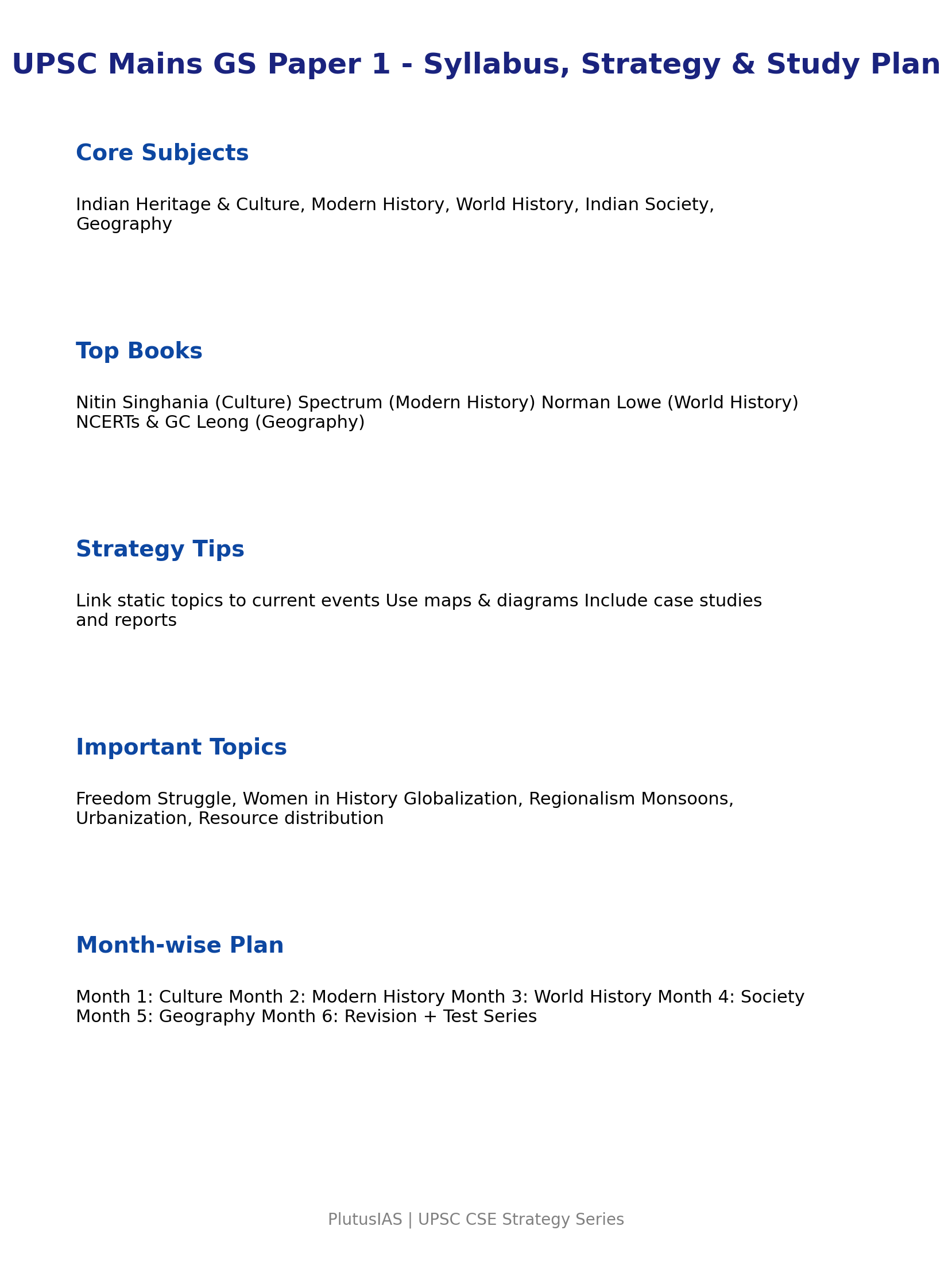
20 May UPSC Mains General Studies Paper 1| GS paper 1
UPSC Mains General Studies Paper 1: Syllabus, Strategy & Study Plan
The General Studies Paper 1 (GS Paper 1) of the UPSC Civil Services Mains Examination plays a vital role in determining your final selection and ranking. This paper tests candidates on subjects that form the foundational understanding of Indian heritage, society, and geography. In this comprehensive guide, we will discuss the syllabus, strategy, and a month-wise study plan to help you score 100+ marks in this paper.
? UPSC GS Paper 1 Syllabus Overview
The GS Paper 1 focuses on static subjects, yet it requires a deep analytical and contemporary understanding of each topic. The main subjects covered include:
- Indian Heritage and Culture
- History (Modern, Ancient, Medieval)
- World History
- Indian Society and Social Issues
- Geography (Physical, Human, and Indian)
Detailed Syllabus
- Indian Heritage and Culture: Salient aspects of Art Forms, Literature, and Architecture from ancient to modern times.
- History: Modern Indian history from the middle of the eighteenth century; personalities and events. The Freedom Struggle and post-independence consolidation.
- World History: Events from the 18th century such as industrial revolution, colonization, world wars, redrawal of national boundaries, and political philosophies like communism, capitalism, socialism, etc.
- Indian Society: Diversity, Salient features, Role of women, Globalization, Social empowerment, Communalism, Regionalism, and Secularism.
- Geography: Physical geography of the world, distribution of natural resources, and important geographical features including water bodies and ice caps. Impact of such features on flora and fauna.
Preparation Strategy for GS Paper 1
1. Understand the Nature of the Paper
This paper tests your knowledge of both factual and analytical content. Unlike GS Paper 2 and 3, it is more static but requires a strong conceptual understanding and contemporary relevance in answers.
2. Prioritize Topics Based on Trends
Analyzing previous years’ questions shows that more weightage is often given to:
- Modern Indian History
- Indian Society and Social Issues
- Indian and World Geography
3. Use Standard Books and Materials
Stick to trusted sources. Here’s a suggested list:
- Indian Art & Culture: Nitin Singhania
- Modern History: Spectrum’s A Brief History of Modern India
- Ancient & Medieval History: Old NCERTs by RS Sharma and Satish Chandra
- World History: Norman Lowe or Vision IAS notes
- Indian Society: NCERTs (Class 11 & 12 Sociology), Yojana, and newspaper editorials
- Geography: NCERTs (6–12), G.C. Leong, and Certificate Physical Geography
4. Integrate Current Affairs
Even though GS Paper 1 is static, current events help you enrich answers with real-life examples. Use newspapers and monthly magazines to find connections.
5. Master the Art of Answer Writing
UPSC expects well-structured answers with balanced perspectives. Practice daily with past year questions and simulated tests. Include:
- Relevant historical dates and events
- Maps, especially in Geography answers
- Examples, case studies, and keywords
Month-wise Study Plan for GS Paper 1
Month 1: Indian Heritage, Art & Culture
- Cover Nitin Singhania thoroughly
- Make short notes on key architecture styles, classical dances, and literature
- Practice PYQs on culture
Month 2: Modern Indian History
- Focus on Spectrum book – timeline-based study
- Cover important personalities and movements
- Use newspaper editorials to relate past with present
Month 3: World History & Post-Independence India
- Use summary notes from Norman Lowe
- Highlight key revolutions, wars, and ideologies
- Post-independence consolidation – refer to Rajiv Ahir’s book or selective chapters from Bipan Chandra
Month 4: Indian Society
- Read NCERT Sociology books (Class 11 & 12)
- Prepare for topics like caste, religion, gender, and regionalism
- Use examples from current events and editorials
Month 5: Geography
- NCERTs for concepts of Geomorphology, Climatology, and Resources
- GC Leong for Physical Geography
- Practice map-based questions
Month 6: Revision and Test Series
- Join a test series (PlutusIAS)
- Revise all short notes and important keywords
- Solve at least 2 GS1 mock papers per week
Important Topics to Focus
- Contribution of Women in Freedom Struggle
- Impact of Globalization on Indian Society
- Industrial Revolution and its impact on India
- Drain of Wealth Theory, Economic Impact of British Rule
- Monsoons and Indian Agriculture
- Urbanization and associated problems
Answer Writing Tips for GS Paper 1
- Structure your answers: Introduction → Body → Conclusion
- Include maps in geography-related questions
- Use flowcharts for societal trends or revolutions
- Cite reports (NFHS, UNESCO) where relevant
- Focus on clarity over jargon
Practice and Revision Tips
- Revise your notes regularly
- Highlight keywords using colored pens for visual memory
- Practice PYQs from last 10 years
- Incorporate feedback from mock tests
Final Checklist for GS Paper 1
- ✅ Art & Culture: Notes + PYQs done
- ✅ Modern & World History: Concept + Timeline clear
- ✅ Society: Examples + Editorial integration
- ✅ Geography: Maps + Diagrams ready
- ✅ Test Practice: 10+ full-length GS1 papers attempted
Conclusion
General Studies Paper 1 is foundational yet deeply analytical. A well-balanced strategy, backed by conceptual clarity and smart revision, can help you secure 100+ marks in this paper. Consistency, daily answer writing, and revision are your best allies. Follow the structured roadmap given above, and you’ll be ready to confidently tackle GS Paper 1 in UPSC Mains.
Good luck with your preparation. Stay focused, stay curious!




No Comments